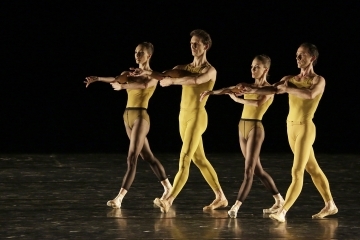New Stage
Artifact Suite To music by Eva Crossman-Hecht and Johann Sebastian Bach Ballet in one act Running time: 40 minutes. Choreography, Costume and Lighting Design: William Forsythe Ballet Masters: Kathryn Bennetts, Noah D. Gelber Costume Production Superviser:Dorothee Merg Lighting Technical Coordination: Tanja Rühl Sound Technical Coordination: Niels Lanz Piano Coach: Margot Kazimirska Artifact Suite, a condensed, pure-dance version of William Forsythe’s full-length ballet, “Artifact” was first presented on 15 September 2004 by the Scottish Ballet. Taken from three sections—parts 1, 2 and 3—of the original 1984 ballet, the work has subsequently taken on a life of its own as an abstract work that distills the protocols and principles of classical ballet into a mesmerizing theatrical event. It opens with a glorious double pas de deux, framed by 30 corps de ballet dancers, set to the Chaconne from Bach’s “Partita No. 2 for solo violin in D minor.” Surging unexpectedly from the symmetrical sleek-bodied rows of dancers lining the sides and back of the stage, two couples perform simultaneous dances of breathtaking beauty, full of off-balance extensions and unexpected shifts of weight. These dramatic pas de deux gloriously elaborate and extend ballet’s formal positions and planes; but these traditions—and our expectations—are abruptly subverted as the curtain crashes down heavily in mid-sequence, only to rise again upon a renewed vision of loveliness. The second section of “Artifact Suite” is set to a piano score by Eva Crossman-Hecht, and its repetitive, urgent lines of sound underscore the image of the corps de ballet as a complex, almost martial machine, with ballet as its precision tool. It offers a demonstration of spectacle and tradition—the visual power of a uniform ensemble, principal dancers, powerfully moving music, a proscenium frame— even as it questions and changes their usage, and our ideas of what ballet can be. Carmen Suite to music by Georges Bizet and Rodion Shchedrin Ballet in one act Adults only Running time: 50 minutes. Libretto Alberto Alonso based on the story Carmen by Prospero Merime Choreographer: Alberto Alonso Designer: Boris Messerer Music Director: Pavel Sorokin Assistant to Choreographer: Sonia Calero Alonso Lighting designer: Alexander Rubtsov Ole, Maya! In 1960s Maya Plisetskaya was officially called Prima ballerina assoluta of The Bolshoi Theatre. She didn’t lack performances, yet the feeling of artistic discontent was growing bigger. She wanted to dance not only classical pieces, but something new, staged specifically for her. After attending performance of the Ballet Nacional de Cuba at end of 1966 that stopped in Moscow during its Soviet tour, an idea to invite Cuban choreographer Alberto Alonso for Carmen ballet production sparked in her mind. She craved for it for some time already. The Bolshoi premiered Carmen Suite on 20 April, 1967. Ballet was completed quite quickly. Music, taken from opera Carmen by George Bizet, was transcripted in a record time by Shchedrin - it took him only twenty days. Splendid and accurate decorations, whose key idea ballet master formulated by this concise sentence: “Bullfighting is Carmen’s entire life”, were designed by well-known theater artist, Maya Plisetskaya’s cousin, Boris Messerer, principal artist of Moscow Art Theatre. Premiere cast (and the only cast for a long time), besides Maya Plisetskaya, included Nikolai Fadeyechev (José), Sergei Radchenko (Bullfighter), Natalia Kasatkina (Fate), Alexander Lavrenyuk (Corregidor); conducted by Gennady Rozhdenstvensky. Baffled by the novelty, audience took ballet quite coldly. One of the few people who unconditionally accepted new performance was Dmitri Shostakovich. He immediately reported on that to the Ministry of Culture. Creators of such unusual and erotic Carmen Suite (clearly interpreted as politically incorrect) desperately needed support as their work was banned right away. “You betrayed classical ballet”, – Soviet Minister of Culture Ekaterina Furtseva would claim outraged. Comments on this statement can be found in the book Portrait of Plisetskaya by Andrei Voznesensky. “In Carmen she first stepped on the soles of her feet, not on pointes, but solidly, flatly, in a flash-and-blood human way”. Ballet was prohibited from being shown at Expo 67 in Canada (tour of The Bolshoi Theatre Ballet troupe was a part of cultural program of exhibition), yet it wasn’t banned there. From time to time Carmen gained success and would tour worldwide. The most precious recognition for Plisetskaya was by Spanish audience “When they (Spanish) shouted out “Ole”, I realized that I won” – she said. “There was an interesting moment in Cuba. After our performance, Raul Castro came backstage. He congratulated artists and greeted Alexander Lavrenyuk, who had a role of Corregidor like this: hello, my military colleague. I think his sarcasm gave evidence that he got it: it was a political performance. Even If there was any evil deed in Carmen, it definitely was the political rationale behind, not the erotic one. In any case, erotica was not welcomed by Soviet government anyway (from interview to The Bolshoi Theatre newspaper, 11.2005). “When telling the story of Carmen she usually mentions that Furtseva strongy recommended her to cover thighs. Spartak that was staged a year later had thighs exposed too. However it was perceived as ideologically correct. Costumes were not the problem. Her costume produced an effect of hyper sexuality onstage. The role interpretation was built around it. And that – like with any other roles as well – attracted to her thousands of people. Combination of imperial kremlin theatre with such apparent sexuality could not leave people indifferent (A. Ratmansky, from booklet for anniversary gala, 2005). Revived in 2005, to celebrate 80th anniversary of legendary artist, ballet continues living its second life on The Bolshoi Theatre stage. Prima ballerinas of different generation at The Bolshoi Theatre decided to try out the title role such as Galina Stepanenko, Maria Alexandrova, Svetlana Zakharova, Ekaterina Shipulina, Ekaterina Krysanova, Anna Nikulina, Olga Smirnova. This list, without any doubt, will be adding more names on it! Nathalie Shadrina | ||||||||||
Main Stage
1 Teatralnaya ploschad (1 Theatre Square), Moscow, Russia
New Stage
Bol'shaya Dmitrovka Street, 4/2, Moscow, Russia


